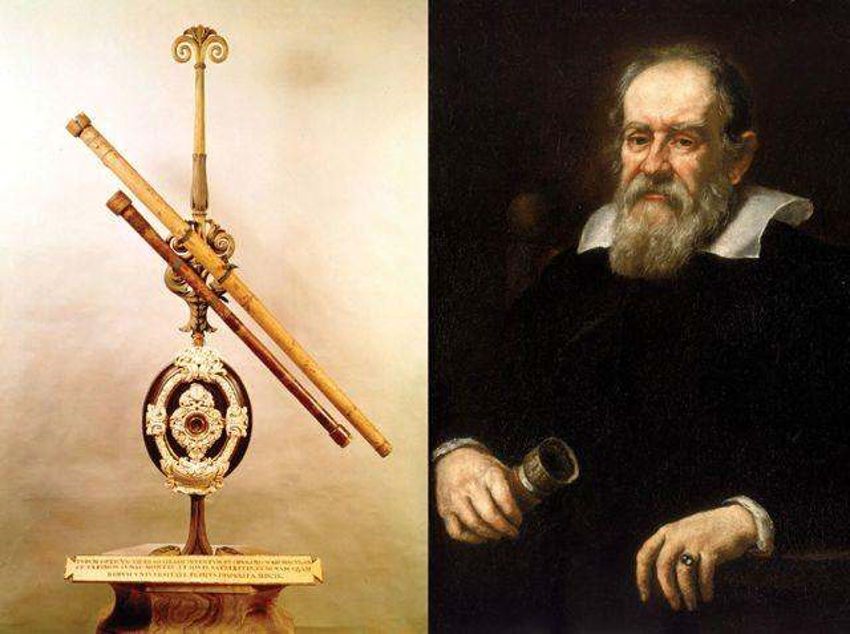Galileo’s Moons
In 1610, Galileo Galilei turned his primitive telescope to Jupiter.
What he saw delighted and amazed him.

Galileo Galilei
He saw four stars strung out in a line beside the disc of the planet.
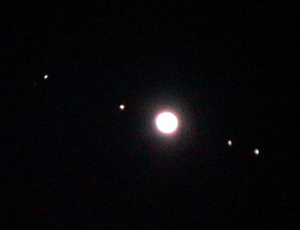
Jupiter & Moons
The tiny ‘stars’changed position from night to night.
Galileo realised that they were moons in orbit around the planet.
That discovery made Galileo realise that not everything revolved round the Earth.
The Earth was not the centre of the universe.
It was a discovery that began the age of science.
No longer would religion and superstition inform us about the cosmos.
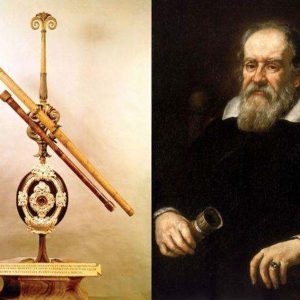
Galileo and his telescope.
In this blog we’ll take a close look at Galileo’s Moons.
Names
Galileo first named the moons for Cosimo Medici, Duke of Tuscany.
It was an attempt to gain patronage from the wealthy aristocrat.
The names that eventually stuck were proposed by German astronomer Simon Marius.
He had discovered the moons independently of Galileo.
Marius named the satellites Io, Europa, Ganymede and Callisto.
These four were lovers of the mighty god Zeus aka Jupiter.
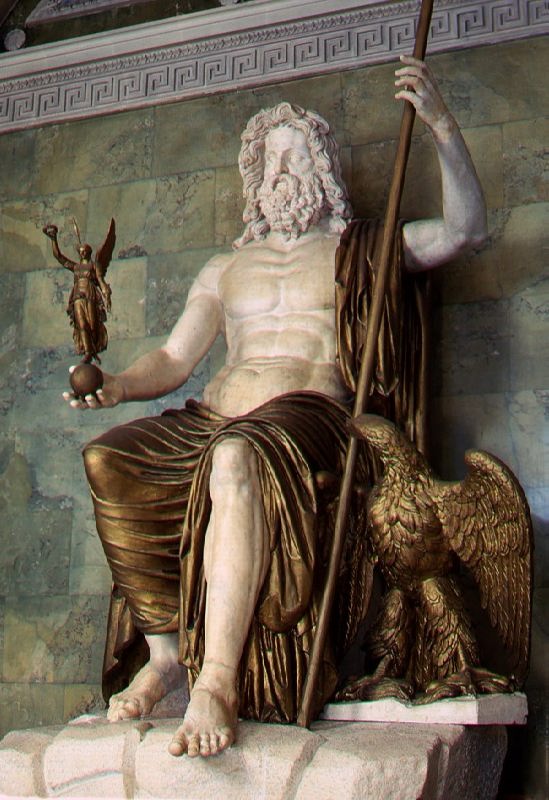
Jupiter, king of the Roman gods
Io
Io is the Galilean Moon closest to Jupiter.
That proximity has a fundamental effect on Io.
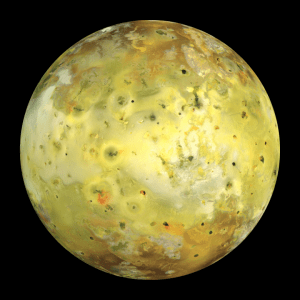
Io: NASA
Io data
- Diameter: 3,643 km, slightly larger than our Moon.
- Orbit distance: 421,800 km
- Orbit time: 1.8 days
- Temperature: – 163 C
Features
Io has over 400 active volcanoes.
It’s the most active volcanic moon in the Solar System.
Volcanic plumes rise to 200 km above the surface.
Sulphur and ash rain down from these plumes.
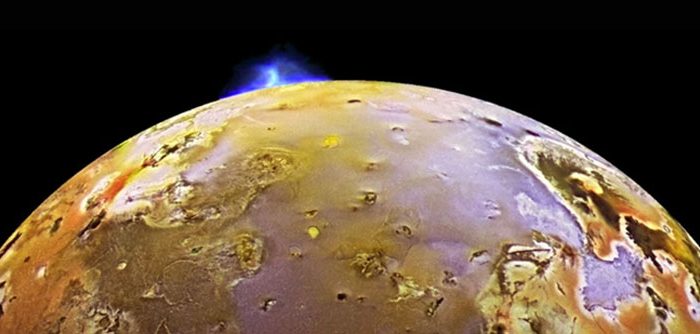
Volcanic plume on Io. NASA
The vulcanism is caused by Jupiter’s gravity pulling one way
and the outer moons tugging Io the other way.
The tidal forces heat Io’s interior so that it is molten.
Some of the ejected material escapes into space.
It forms a thin ring of particles around Jupiter.
Europa
Europa is probably the most intruiging of Galileo’s Moons.
It may possibly harbour alien life.
Europa data
- Diameter: 3,100 km, slightly smaller than our Moon
- Orbit distance: 671,000 km
- Orbit time: 3.5 days
- Temperature: – 200 C
Features
The interior of Europa is silicate rock.
But the whole moon is covered in a shell of water ice.
Beneath that ice there may be an ocean of salt water.
And, of course, where there is water there may be life.

Europa from Galileo space probe. NASA
The water around Europa is around 100 km thick.
The top layer is frozen, with liquid water beneath.
There are many cracks in the ice layer.
In our Wonderdome shows, we often feature a dive down one of these cracks into the ocean beneath.
We see that there may be strange alien life in the ocean of Europa!
Ganymede
Ganymede is the largest of Jupiter’s moons.
In fact it is the largest moon in the Solar System, bigger than planet Mercury.

Ganymede Credit: NASA
Ganymede data
- Diameter: 5,268 km
- Orbit distance: 1,070,000 km
- Orbit time: 7.1 days
- Temperature: – 170 C
Features
Like Europa, Ganymede is covered in a layer of ice.
The ice is around 150 km thick.
And, like Europa, there may be an ocean of water beneath the ice.
Latest estimates put the ocean at 100 km deep.
If this is true, then there is more water on Ganymede than on Earth.
And this water brings the prospect of alien life on another Jovian moon.
The surface has two types of terrain.
Almost half the moon is dark and heavily cratered.
The rest is light in colour and criss-crossed by grooves in the ice.
The grooves reach up to 700 metres high and stretch for hundreds of kilometres across the surface.
Callisto
Callisto is the outermost of Galileo’s moons.
It is the second biggest of Jovian satellites and the third biggest moon in the Solar System.
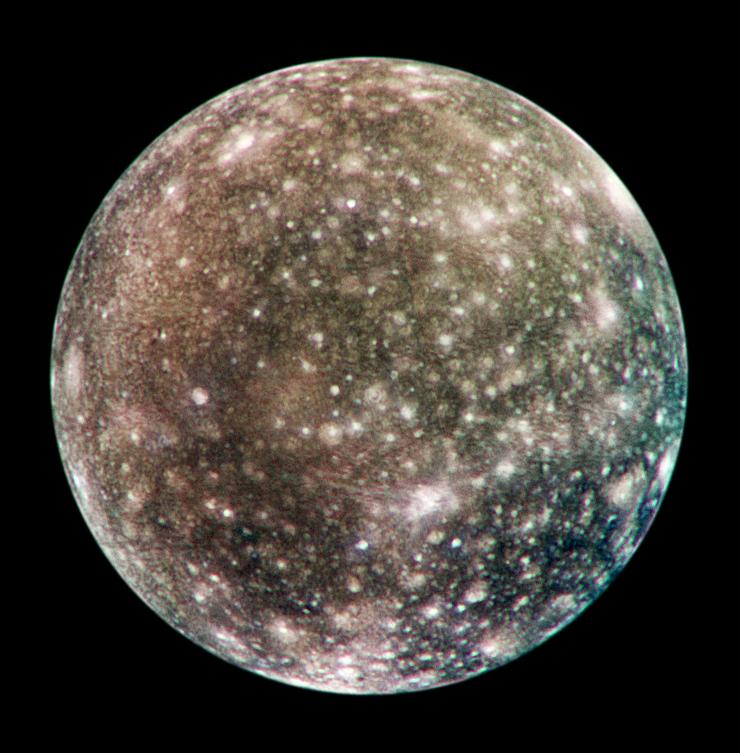
Callisto. Image: NASA
Callisto data
- Diameter: 4,820 km
- Orbit distance: 1,883,000 km
- Orbit time: 17 days.
- Temperature: – 170 C
Features.
Callisto is tidally locked with Jupiter, so the same side always faces the planet.
Like the previous two moons, Callisto’s surface is a layer of ice.
It is an ancient surface, some 4 billion years old.
The ice is covered in craters.
Callisto is the most heavily cratered body in the Solar System.
Like Europa and Ganymede, there may be a liquid water ocean beneath the icy shell.
The interior is probably a mixture of rock and ice.
The largest crater on Callisto is Valhalla, some 3,600 km across.
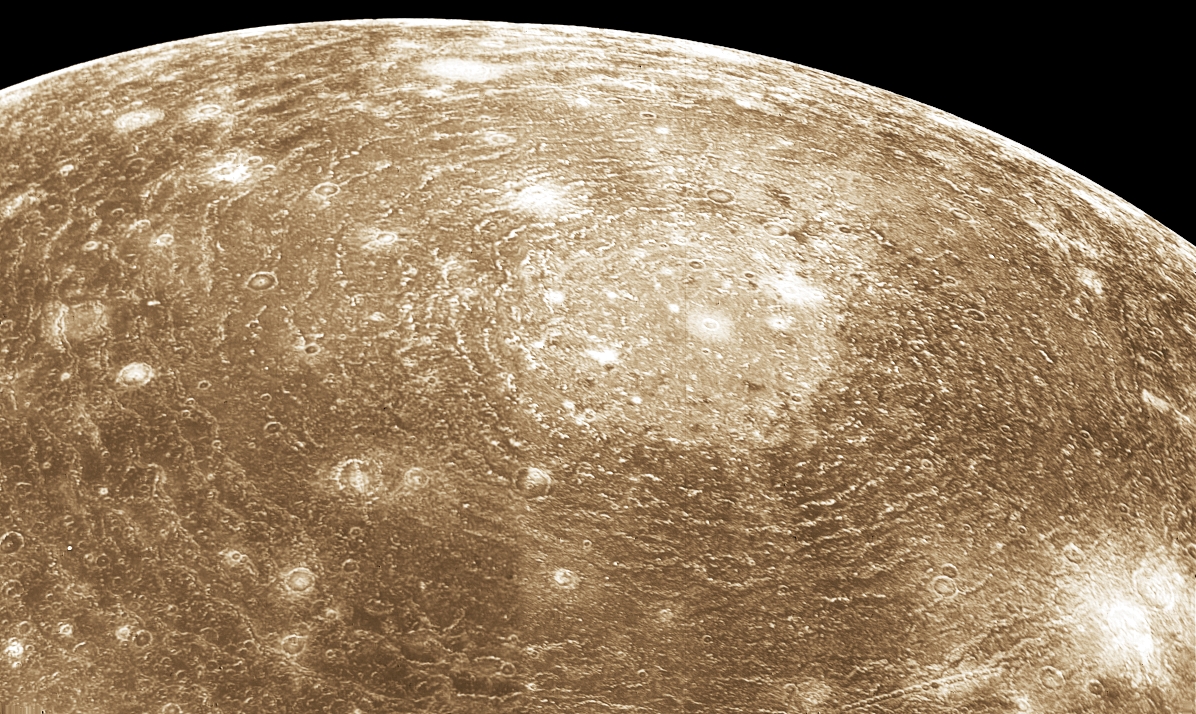
Valhalla. Credit: NASA, Voyager
When the meteorite struck Callisto, it melted the ice.
The water flowed in waves, then froze solid.
Those waves are frozen in time as the concentric rings circling the impact site.
Future Space Probes
Jupiter’s moons will be visited by three space probes in coming years.
The European Space Agency’s JUICE mission will visit the icy moons rom 2031 to 2034.
NASA’s Europa Clipper will be launched next year and reach Europa in 2030.
China hopes to join the exploration in 2029, when it launches Tianwen-4.
This probe will orbit Callisto in 2035.
There is much more to be learned about Galileo’s moons.
These new robot spacecraft will tell us more about these fascinating worlds.
Galileo and you
Now is a good time for you to re-enact Galileo’s discovery.
Jupiter is well placed in the southern sky.
With the naked eye it is brighter than any star.
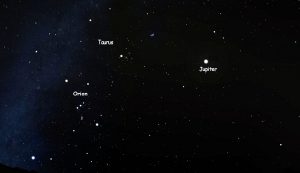
Jupiter in 2023. Credit: Stellarium
With a telescope or binoculars the four great moons come into view.
If you are using binoculars, lean on a wall or fence to hold them steady.
You will see the moons as tiny points of light in line near the planet disc.
Sometimes not all four are in view.
Some may be hidden behind Jupiter.

Jupiter & moons, small telescope
Several websites have guides to identifying each moon at a particular time.
One such is at Sky & Telescope
Here’s the link:
If you observe for several nights, you’ll see the dance of the moons around Jupiter.
If you do observe these four moons, think of Galileo.
Imagine his delight when he first saw them over 400 years ago.

The author: Dennis Ashton is a Fellow of the Royal Astronomical Society and a Wonderdome presenter.
Would you like to hear more Astronomy news?
Do you want to to find out about our upcoming public events?
Follow WonderDome Portable Planetarium on Twitter and Facebook or go to our web site wonderdome.co.uk

